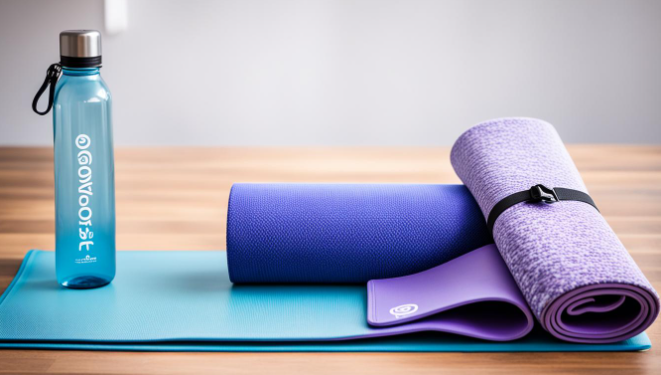What to Bring to Yoga Class: Essential Gear Guide
Must-Have Items for a Successful and Comfortable Yoga Practice

1. Yoga Mat: The Foundation of Your Practice
A quality yoga mat is the primary piece of equipment every yogi needs. The mat provides a clean, cushioned surface to practice on and establishes your own space in class. When choosing a mat, consider factors like thickness, material, and grip:
- Thickness: Standard yoga mats are around 1/8-inch thick, which provides enough padding for most people without being overly bulky. However, if you have sensitive joints or prefer more cushioning, you may want a thicker mat (about 1/4-inch).
- Material: Mats come in a variety of materials, including PVC, rubber, and eco-friendly options like cork or natural rubber. Eco-conscious practitioners may prefer natural materials, while those needing extra grip might find PVC mats more suitable.
- Grip: Look for mats with a non-slip texture, which is especially important if you tend to sweat or practice hot yoga. A mat with a good grip helps prevent sliding during poses, allowing you to focus on alignment.
Many studios offer rental mats, but bringing your own is more hygienic, especially since you’ll be lying, sitting, and placing your hands and feet directly on it. Plus, having a mat you’re familiar with can improve comfort and consistency in your practice.
2. Comfortable, Flexible Clothing
Comfortable clothing is essential for yoga, allowing you to move freely and breathe comfortably. Look for items specifically designed for physical activity, such as:
- Tops: Choose breathable, moisture-wicking tops. Tank tops or fitted t-shirts work well, as they stay in place during movement. In cooler settings, you might opt for a lightweight long-sleeve.
- Bottoms: High-waisted leggings, yoga pants, or shorts are popular choices. Avoid overly loose pants, as they may bunch up or restrict your movement during certain poses.
- Layers: If your studio has a strong AC or if you practice restorative or yin yoga, bringing a light cover-up, such as a hoodie or a sweater, can be helpful for warmth during slower poses or savasana (final relaxation).
Yoga clothing doesn’t need to be elaborate or high-end—anything that stretches, breathes well, and doesn’t hinder your movement will work. The key is feeling comfortable and focused.
3. Water Bottle for Hydration
While yoga isn’t as cardio-intensive as other workouts, staying hydrated is essential, particularly for hot yoga classes or lengthy sessions. A good water bottle will help you keep hydrated before, during breaks, and after class. Consider a bottle with the following features:
- Insulation: Insulated bottles keep water cool in hot yoga sessions.
- Ease of Use: Bottles with easy-open caps or spouts allow you to take quick sips without fussing with lids.
Staying hydrated is particularly important in a heated environment, so make sure to have water on hand, even if you don’t drink it often during the class.
4. Towel for Sweat Management
Yoga can work up a sweat, especially in more intense or hot yoga classes. A towel will help you manage moisture, improving grip and comfort. You may consider two types of towels:
- Hand Towel: A small towel to wipe your hands, face, or mat as needed. These are lightweight and fit easily next to your mat.
- Mat Towel: A larger towel that covers the entire mat, providing additional grip if you sweat a lot or if the mat itself is slippery.
Some yogis swear by mat towels in heated or power yoga, as they prevent slipping and help you stay grounded. If you’re just starting, a small hand towel should be enough until you know your personal needs better.
5. Yoga Props: Blocks, Straps, and Bolsters
Yoga props aren’t always necessary, but they can be incredibly helpful, particularly if you’re new or working on flexibility and strength. Many studios provide props, but if you prefer to bring your own or your studio doesn’t offer them, here are a few to consider:
- Yoga Blocks: Blocks are invaluable for support in poses where you can’t quite reach the floor. They can also help with alignment and allow you to explore variations of poses.
- Yoga Strap: A strap can help with flexibility, especially in poses that require you to reach or stretch. Straps are great for hamstring and shoulder stretches and allow you to ease into a pose at your own pace.
- Yoga Bolster: Bolsters aren’t typically required, but they can add comfort in restorative poses and provide support in deep stretches. If you enjoy slower, restorative classes, consider bringing one.
Props can make yoga more accessible, especially if you’re a beginner, allowing you to deepen poses safely and comfortably.
6. Yoga Bag for Carrying Essentials
To transport your mat and other essentials, a yoga bag can be handy. Yoga bags come in various forms, from simple slings to fully zipped carriers that accommodate a mat, towel, and even a change of clothes.
- Mat Sling: This is a simple option for carrying your mat to and from class.
- Full Yoga Bag: If you bring a towel, water bottle, and other accessories, a full yoga bag with compartments is a more practical choice.
Having a bag helps keep your gear organized, especially if you’re heading to class from work or school.
7. Personal Care Essentials
After a rejuvenating yoga class, you may want to freshen up, particularly if your studio doesn’t have shower facilities. Bringing along a few personal care items can make this process easier:
- Face Wipes or a Small Towel: Wipes can help you feel refreshed after a class, especially if you’ve been sweating.
- Deodorant: A travel-size deodorant is convenient if you’re heading somewhere after class.
- Hair Ties or Headbands: If you have long hair, you’ll want it out of your face. A headband or hair tie will prevent your hair from getting in the way and help you focus on your poses.
8. Journal or Notebook for Reflection
Yoga is often as much a mental journey as a physical one. Many practitioners find that writing down thoughts, reflections, or goals after class helps them connect more deeply to their practice. Consider keeping a small journal in your bag to jot down any insights you gain during or after your session.
9. Mindset: Bring an Open Mind and Positive Attitude
While not a physical item, an open mind and a positive attitude are perhaps the most important things to bring. Yoga isn’t about perfect poses or competition—it’s a personal practice, and every class can be different. Embrace your current abilities, listen to your body, and remember that yoga is a journey.
In Summary: Packing for a Purposeful Practice
Preparing for a yoga class can be simple and streamlined when you know what to bring. The essentials—a yoga mat, comfortable clothing, a water bottle, and a towel—will equip you for most classes. Depending on your personal needs and the style of yoga, you may want to add props like blocks, a strap, or even a bolster for added comfort and support.
Ultimately, the goal is to bring items that enhance your practice, making it more comfortable, safe, and enjoyable. With the right gear, you’ll be able to focus on the practice itself, immersing in the peace, flexibility, and strength yoga brings to both body and mind. Whether you’re a seasoned yogi or a beginner, having the right items on hand will support your journey, allowing you to grow.


